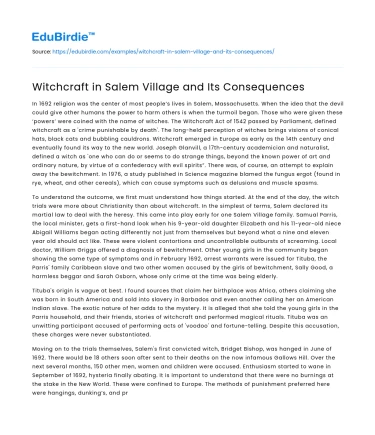In 1692 religion was the center of most people’s lives in Salem, Massachusetts. When the idea that the devil could give other humans the power to harm others is when the turmoil began. Those who were given these ‘powers’ were coined with the name of witches. The Witchcraft Act of 1542 passed by Parliament, defined witchcraft as a 'crime punishable by death'. The long-held perception of witches brings visions of conical hats, black cats and bubbling cauldrons. Witchcraft emerged in Europe as early as the 14th century and eventually found its way to the new world. Joseph Glanvill, a 17th-century academician and naturalist, defined a witch as 'one who can do or seems to do strange things, beyond the known power of art and ordinary nature, by virtue of a confederacy with evil spirits”. There was, of course, an attempt to explain away the bewitchment. In 1976, a study published in Science magazine blamed the fungus ergot (found in rye, wheat, and other cereals), which can cause symptoms such as delusions and muscle spasms.
To understand the outcome, we first must understand how things started. At the end of the day, the witch trials were more about Christianity than about witchcraft. In the simplest of terms, Salem declared its martial law to deal with the heresy. This came into play early for one Salem Village family. Samual Parris, the local minister, gets a first-hand look when his 9-year-old daughter Elizabeth and his 11-year-old niece Abigail Williams began acting differently not just from themselves but beyond what a nine and eleven year old should act like. These were violent contortions and uncontrollable outbursts of screaming. Local doctor, William Griggs offered a diagnosis of bewitchment. Other young girls in the community began showing the same type of symptoms and in February 1692, arrest warrants were issued for Tituba, the Parris' family Caribbean slave and two other women accused by the girls of bewitchment, Sally Good, a harmless beggar and Sarah Osborn, whose only crime at the time was being elderly.
Tituba's origin is vague at best. I found sources that claim her birthplace was Africa, others claiming she was born in South America and sold into slavery in Barbados and even another calling her an American Indian slave. The exotic nature of her adds to the mystery. It is alleged that she told the young girls in the Parris household, and their friends, stories of witchcraft and performed magical rituals. Tituba was an unwitting participant accused of performing acts of 'voodoo' and fortune-telling. Despite this accusation, these charges were never substantiated.
Moving on to the trials themselves, Salem's first convicted witch, Bridget Bishop, was hanged in June of 1692. There would be 18 others soon after sent to their deaths on the now infamous Gallows Hill. Over the next several months, 150 other men, women and children were accused. Enthusiasm started to wane in September of 1692, hysteria finally abating. It is important to understand that there were no burnings at the stake in the New World. These were confined to Europe. The methods of punishment preferred here were hangings, dunking’s, and pressings. Oddly enough, if you survived any of these punishments, you were a witch and if you died you were innocent.
Tituba was beaten into coercion by Reverend Parris and rehearsed on what to say. She was pressed into saying the Devil had spoken directly to her and through her. Tituba was interrogated at least five times, more than any other defendant, for great lengths of time. She at one point admitted to flying on a pole between houses and attacking sleeping children. Her confession, coerced or otherwise, set the stage for upcoming questioning and punishment. Tituba, in exchange for naming names and her confession to witchcraft, would be spared a severe punishment like hanging. Tituba's confession gave validation to the initial witchcraft charges. Other accused followed the precedent set by Tituba and confessed hoping to see their trials postponed as well.
Interrogations were preformed where the accusers and accused were not only together in a room but questioned at the same time. This allowed for intimidation of both accused and accuser to take place in the open, and blatantly. This tactic served to elicit more accusations toward people who were only present to witness the proceedings. One of the notables in this situation was Martha Corey. She had heard rumors of her indictment of witchcraft. Martha confronted her accusers head-on. When they came to her home to bring the accusation(s) she merely said, “I cannot help people talking of me”. Her primary accuser had been a twelve-year-old girl who claimed Martha Corey had “blinded her and told her that she should see you no before it was night, that she might not tell us what clothes you had on”.
Martha professed her innocence by assuring her callers that she was a ‘woman of God’. She was reminded at the time by her deacon that a profession of faith was not a verdict of innocent. The warrant for Martha's arrest went out the following day, Saturday, but would not be executed till after the Sabbath. This allowed Martha to attend meeting and stand alongside of her accusers.
There are many hypotheses still being formulated about what truly happened during the Salem Witch Trials. Numerous innocent lives were taken in this hunt for evil witches. The strange chain of events leaves many mysteries and unanswered questions behind for researchers today.






 Stuck on your essay?
Stuck on your essay?

